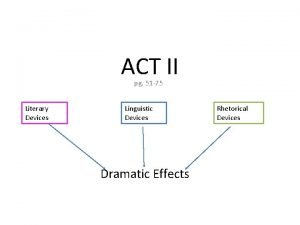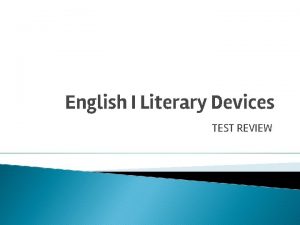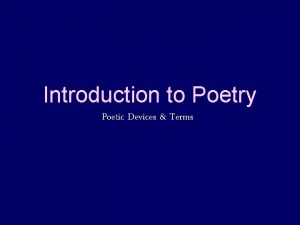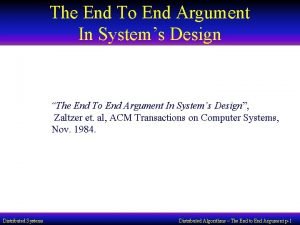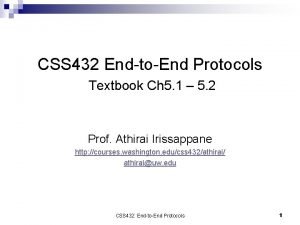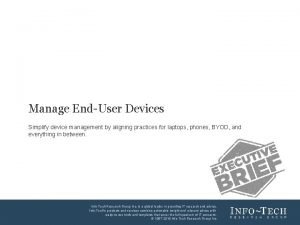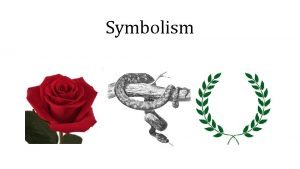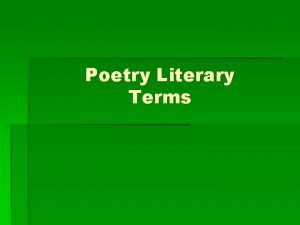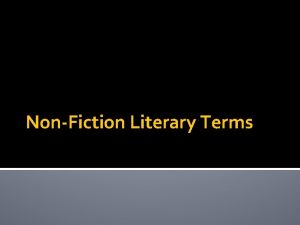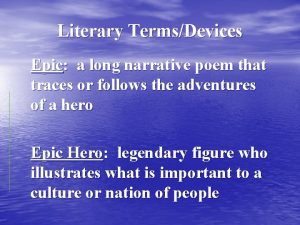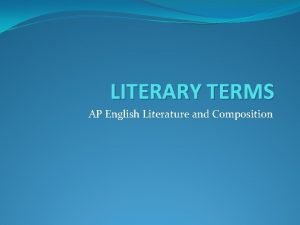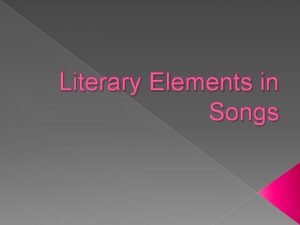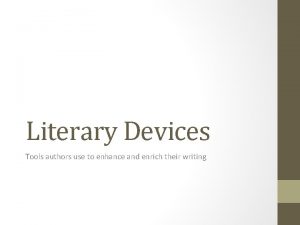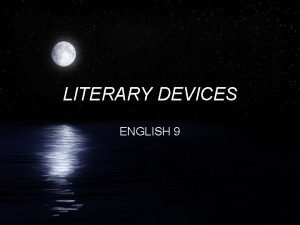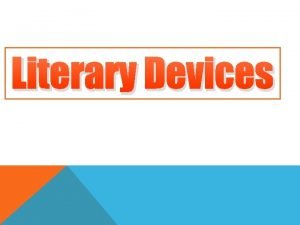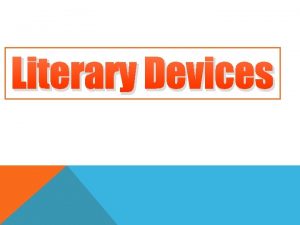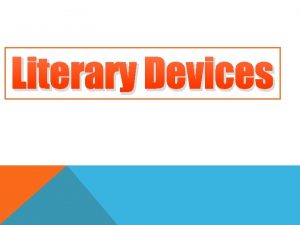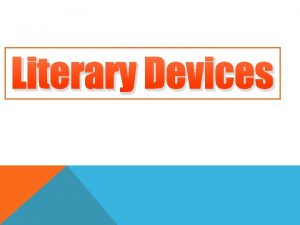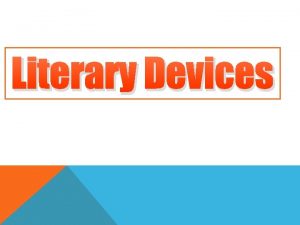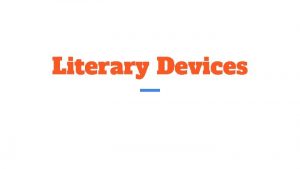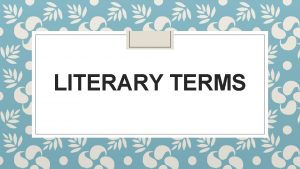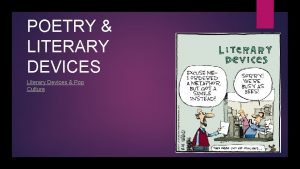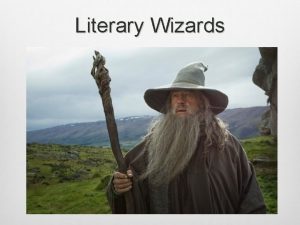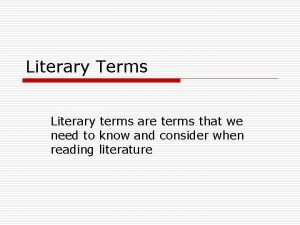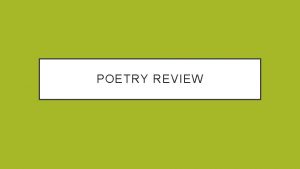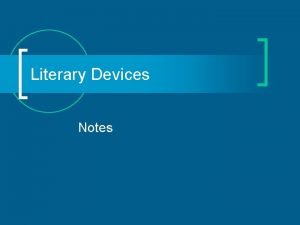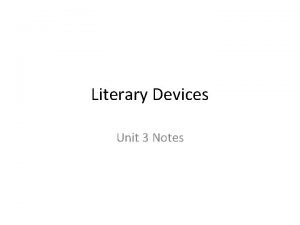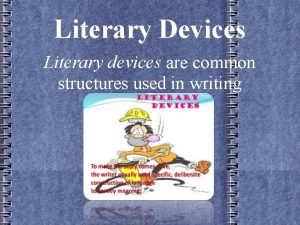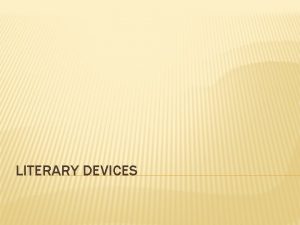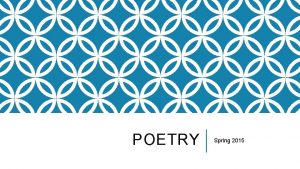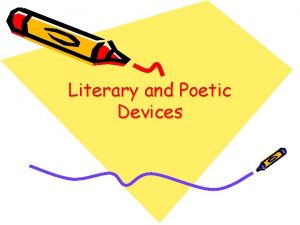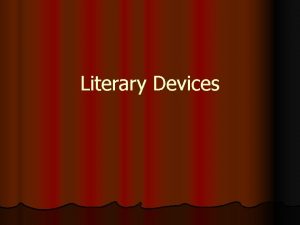Literary Terms End of Course Test Literary Devices


































- Slides: 34

Literary Terms: End of Course Test

Literary Devices n n n Literary devices are a way to improve the effectiveness, clarity, and enjoyment of writing. Authors of nonfiction, poetry, and drama use a variety of literary devices to create emotional mood, an attitude, a setting, and characterization. Literary devices are one of the most effective ways an author can persuade his audience.

Plot The series of events and actions that takes place in a story.

Plot Using a book or story you recently read, identify 5 events that took place in the plot.

Setting: • The time and place in which the action occurs. • Setting can establish the atmosphere of a work. • Setting can help in the portrayal of character. Night: Poland, 1940 s Lord of the Flies: deserted island, the future.

Setting: • Using a movie you recently watched, identify the setting. • How did the setting impact characters in the movie and the decisions they made?

Point of View: Who is telling the story? First Person: Story is told from the point of view of one of the characters who uses the first person pronoun “I. ” Second Person: Story is told through the use of “you”; may be for instructional purposes.

Point of View: Con’t Third Person: The author tells the story using information he obtains from using his five senses. Third Person Limited: The author knows only the thoughts and feelings of the main character. Third Person Omniscient: The reader knows the thoughts and feelings of more than one character.

Point of View Identify the point of view in the following excerpt: If there is anything more half-witted than asking six adolescents in backward-facing baseball caps for a dining recommendation, then it doesn’t occur to me just at the moment, but I’m afraid this is what I did now. “Are you an American? ” asked one of the kids in a tone of surprise that I wouldn’t necessarily have expected to encounter in a world capital. I allowed that I was. “There’s a Mc. Donald’s just around the corner. ”

Methods of Characterization Direct: The character traits are directly stated in the text. Indirect: The reader must decide for themselves what the character is like through the character's thoughts, actions, speech, looks and interaction with other characters.

Methods of Characterization Is the example below an example of direct or indirect characterization? Example: “he was an old man. . ” (The Old Man and the Sea) • Give an example of direct characterization using the person who sits in front of you. Is the example below an example of direct or indirect characterization? Example: When the teacher turned her back to the class, Tom copied his friend’s answers on the test. When he noticed Billy watching him, he glared at him to keep him quiet. • What can you conclude about Billy from this example?

Tone & Mood n Tone: The apparent emotional state, or “attitude, ” of the speaker/narrator/narrative voice, as conveyed through the language of the piece. ¨ Example: The poem has a bitter and sardonic tone, revealing the speaker’s anger and resentment. n Mood: Mood refers to the general sense or feeling which the reader is supposed to get from the text. ¨ Examples: sad, happy, angry, and frustrated.

E N O T Author MO OD Reade

Identify Tone & Mood n Identify tone and mood in the following excerpt. I’m writing in response to that maniac who is suing the city for damages to his truck that he says were caused by the speed bumps installed on Davies Road. I live on Davies Road, and as any first grader would tell you, the speed bumps aren’t the cause for damage to anything. It’s fools like this guy who are responsible for higher insurance costs and probably every other problem in our city.

Symbolism Using an object or action that means something more than its literal meaning. Examples: A Journey can symbolize life. Black can represent evil or death. Water may represent a new beginning. A lion could be a symbol of courage.

Symbolism Draw your own symbol and be prepared to explain what it symbolizes. Volunteer examples:

Theme (also called Main Idea) n The main idea or message conveyed by the piece. A theme should generally be expressed as a complete sentence, and it must be universal. ¨ Example of Central Theme in Lord of the Flies: Human beings are essentially brutal, savage creatures.

Theme (also called Main Idea) Choose a story that most students have read (Romeo and Juliet). n Choose 3 one word topics discussed in this piece (love, death, family). n What is the author trying to say about each of these topics? Make sure it is a sentence, and it is universal. n ¨ Love can make people do crazy things. ¨ ¨

Personification n Giving human qualities to animals or objects. ¨ Examples: n a smiling moon n a jovial sun

Personification n Create your own examples of personification with two of the following objects: ¨ Examples: n a desk n a car n a tree n an I-pod

Simile n The comparison of two unlike things using like or as. ¨ Examples: n He eats like a pig. n Vines like golden prisons.

Metaphor n Related closely to simile in that it compares 2 unlike things, but a metaphor does NOT use like or as. ¨ Examples: n He is a pig. n The vines are golden prisons.

Extended Metaphor n A metaphor that continues into the sentences that follow. ¨ Example: If one starts with the metaphor of "The seeds of discontent have already been sown", an extension could be "It remains to see whether weed or flower will spring forth. "

Simile and Metaphor n Create your own example of a simile by comparing any two things you choose. n Now take the simile you created and turn it into a metaphor. n Now elaborate on the metaphor you created to turn it into an extended metaphor. This will take a couple extra sentences of comparisons.

Foreshadowing n Use of hints or clues to suggest what will happen later in literature. ¨Example: In Romeo and Juliet, several times the two youths mention their longing to die. Once, Juliet even mentions that Romeo appears pale, as if he is in a tomb. These instances foreshadow the deaths of the lovers.

Foreshadowing n Identify an example of foreshadowing in the following excerpt. Tell what these hints or clues might be foreshadowing. I’d had my driver’s license for exactly three days when I made a left turn at precisely the wrong time. I was alone in the car, the music wasn’t on, my blinker was flashing, the light was green, and the roads were dry. What could go wrong? I was the best driver on the planet, and I was invincible. With the courage that only comes from inexperience, I turned directly in front of a maroon convertible carrying four equally courageous guys about my age.

Irony n An implied discrepancy between what is said and what is meant. ¨ Examples/3 Types: 1. verbal irony is when an author says one thing and means something else. 2. dramatic irony is when an audience knows something that a character in the literature does not know. 3. situational irony is when a reader expects one thing to happen but something different does.

Irony n Identify the types of irony in the following examples: ¨ In a scary movie, when you can see a masked man standing behind the main character. ¨ We expect Juliet to save Romeo, but instead both characters end up dead.

Imagery (sometimes called sensory details) n Language that evokes one or all of the five senses: seeing, hearing, tasting, smelling, touching. ¨ Example: Her eyelashes were like the legs of a black widow spider and brushed against my cheek as soft as a baby's breath. n Extra Credit!: Which other literary device is this an example of?

Imagery (sometimes called sensory details) n Describe FHN in 2 sentences using at least three of the five senses:

Foil n Foil is a secondary character that contrasts with a major character in the story. ¨ The purpose of the foil character is to emphasize the traits of the main character by comparison or contrast. So: * Who is the main character? * What are his or her traits? * Which characters exhibit the opposite traits?

Foil n In the movie Batman, which two characters would be considered foils? Answer the following questions to determine your answer. Who is the main character? What are his or her traits? Which characters exhibit the opposite traits?

Jargon n Jargon – terminology that relates to a specific group or profession n Examples: Sports Jargon: ¨ shut out, choked, n Class Examples for Medical Jargon:

Slang n Slang – informal words that are not considered standard language n Examples: Whack, check it, shut it, what’s up n Class Examples:
 75 literary terms elements and devices
75 literary terms elements and devices What are literary techniques
What are literary techniques Polynomial classification
Polynomial classification What are like terms
What are like terms Literary devices test
Literary devices test T junction of stretcher bond
T junction of stretcher bond Course number and title
Course number and title Course interne course externe
Course interne course externe Hbs eoc study guide
Hbs eoc study guide What are poetic devices
What are poetic devices What is the volume of blood pumped per minute
What is the volume of blood pumped per minute Edv and preload
Edv and preload Front end of compiler
Front end of compiler Back end
Back end Kolondivertikulose definition
Kolondivertikulose definition Yichao zhou
Yichao zhou End to end argument in system design
End to end argument in system design End to end accounting life cycle tasks
End to end accounting life cycle tasks Protect
Protect End to end delay
End to end delay End to end
End to end Automatic knowledge graph construction
Automatic knowledge graph construction End-to-end procurement life cycle
End-to-end procurement life cycle Blackberry devices working on january
Blackberry devices working on january Jeopardy literary terms
Jeopardy literary terms Symbol literary term
Symbol literary term Literature symbol
Literature symbol Five figure of speech
Five figure of speech Nonfiction literary terms
Nonfiction literary terms Literary terms epic
Literary terms epic Ap english literature terms
Ap english literature terms A comparison not using like or as
A comparison not using like or as Symbol literary element
Symbol literary element Jumbo shrimp literary device
Jumbo shrimp literary device Ottava rima examples
Ottava rima examples
